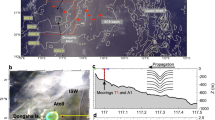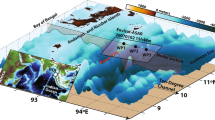Abstract
Satellite images have long revealed the surface expression of large amplitude internal waves that propagate along density interfaces beneath the sea surface1,2,3. Internal waves are typically the most energetic high-frequency events in the coastal ocean4,5,6, displacing water parcels by up to 100 m and generating strong currents and turbulence7 that mix nutrients into near-surface waters for biological utilization. While internal waves are known to be generated by tidal currents over ocean-bottom topography8,9,10,11,12,13, they have also been observed frequently in the absence of any apparent tide–topography interactions1,7,14. Here we present repeated measurements of velocity, density and acoustic backscatter across the Columbia River plume front. These show how internal waves can be generated from a river plume that flows as a gravity current into the coastal ocean. We find that the convergence of horizontal velocities at the plume front causes frontal growth and subsequent displacement downward of near-surface waters. Individual freely propagating waves are released from the river plume front when the front's propagation speed decreases below the wave speed in the water ahead of it. This mechanism generates internal waves of similar amplitude and steepness as internal waves from tide–topography interactions observed elsewhere11, and is therefore important to the understanding of coastal ocean mixing.
This is a preview of subscription content, access via your institution
Access options
Subscribe to this journal
Receive 51 print issues and online access
$199.00 per year
only $3.90 per issue
Buy this article
- Purchase on Springer Link
- Instant access to full article PDF
Prices may be subject to local taxes which are calculated during checkout




Similar content being viewed by others
References
Fu, L. L. & Holt, B. Seasat Views Oceans and Sea Ice with Synthetic-Aperture Radar (JPL publication 81–120, NASA Jet Propulsion Laboratory, Pasadena, 1982)
Jackson, C. & Apel, J. An atlas of internal solitary-like waves and their properties. http://www.internalwaveatlas.com/Atlas2_index.html 2004.
Ray, R. D. & Mitchum, G. T. Surface manifestation of internal tides generated near Hawaii. Geophys. Res. Let. 23, 2101–2104 (1996)
Huthnance, J. M. Internal tides and waves near the continental shelf edge. Geophys. Astrophys. Fluid Dyn. 48, 81–105 (1989)
Osborne, A. R. & Burch, T. L. Internal solitons in the Andaman Sea. Science 208, 451–460 (1980)
Ostrovsky, L. & Stepanyants, Y. Do internal solitons exist in the ocean? Rev. Geophys. 27, 293–310 (1989)
Moum, J. N., Farmer, D. M., Smyth, W. D., Armi, L. & Vagle, S. Structure and generation of turbulence at interfaces strained by internal solitary waves propagating shoreward over the continental shelf. J. Phys. Oceanogr. 33, 2093–2112 (2003)
Maxworthy, T. A note on the internal solitary waves produced by tidal flow over a three-dimensional ridge. J. Geophys. Res. 84, 338–346 (1979)
Lamb, K. G. Numerical experiments of internal wave generation by strong tidal flow across a finite amplitude bank edge. J. Geophys. Res. 99, 843–864 (1994)
Chereskin, T. K. Generation of internal waves in Massachusetts Bay. J. Phys. Oceanogr. 88, 2649–2661 (1983)
Loder, J. W., Brickman, D. & Horne, E. P. W. Detailed structure of currents and hydrography on the northern side of Georges Bank. J. Geophys. Res. 97, 14331–14351 (1992)
Farmer, D. M. & Smith, J. D. in Hydrodynamics of Estuaries and Fjords (ed. Nihoul, J.) 465–493 (Elsevier, Amsterdam, 1978)
Farmer, D. M. & Armi, L. The generation and trapping of solitary waves over topography. Science 283, 188–190 (1999)
Stanton, T. P. & Ostrovsky, L. A. Observations of highly nonlinear internal solitons over the continental shelf. Geophys. Res. Lett. 25, 2695–2698 (1998)
Sutherland, B. R. Interfacial gravity currents. I. Mixing and entrainment. Phys. Fluids 14, 2244–2254 (2002)
Simpson, J. E. Gravity Currents in the Environment and Laboratory (Cambridge Univ. Press, Cambridge, UK, 1987)
Christie, D. R., Muirhead, K. J. & Clarke, R. H. Solitary waves in the lower atmosphere. Nature 293, 46–49 (1981)
Smith, R. K., Crook, N. & Roff, G. The Morning Glory: An extraordinary atmospheric undular bore. Q. J. R. Meteorol. Soc. 108, 937–956 (1982)
Doviak, R. J., Chen, S. S. & Christie, D. R. Thunderstorm-generated solitary wave observation compared with theory for nonlinear waves in a sheared atmosphere. J. Atmos. Sci. 48, 87–111 (1991)
Rao, M. P., Castracane, P., Casadio, S., Fua, D. & Fiocco, G. Observations of atmospheric solitary waves in the urban boundary layer. Boundary-Layer Meteorol. 111, 85–108 (2004)
Rottman, J. W. & Simpson, J. E. The formation of internal bores in the atmosphere: A laboratory model. Q. J. R. Meteorol. Soc. 115, 941–963 (1989)
Maxworthy, T., Leilich, J., Simpson, J. E. & Meiburg, E. H. The propagation of a gravity wave into a linearly stratified fluid. J. Fluid Mech. 453, 371–394 (2002)
Orton, P. M. & Jay, D. A. Observations at the tidal plume front of a high-volume river outflow. Geophys. Res. Lett. 32, L11605 doi:10.1029/2005GL02237 (2005)
Britter, R. E. & Simpson, J. E. Experiments on the dynamics of a gravity current head. J. Fluid Mech. 88, 223–240 (1978)
Luketina, D. A. & Imberger, J. Characteristics of a surface buoyant jet. J. Geophys. Res. 92, 5435–5447 (1987)
Drazin, P. G. & Reid, W. H. Hydrodynamic Stability (Cambridge Univ. Press, Cambridge, 1981)
O'Donnell, J. & Garvine, R. W. A time dependant, two layer frontal model of buoyant plume dynamics. Tellus A 35, 73–80 (1983)
Duda, T. F. et al. Internal tide and nonlinear internal wave behaviour at the continental slope in the Northern South China Sea. IEEE J. Ocean. Eng. 20, 1105–1130 (2004)
Moum, J. N., Gregg, M. C., Lien, R. C. & Carr, M. Comparison of turbulence kinetic energy dissipation rate estimates from two ocean microstructure profilers. J. Atmos. Ocean. Technol. 12, 346–366 (1995)
Acknowledgements
We thank M. Neeley-Brown, R. Kreth and A. Perlin for their technical expertise. L. Kilcher, T. Kimura, R. Bjorkquist, A. Horner-Devine, T. Chisholm, and the captain and crew of the RV Pt. Sur made data collection possible. Satellite imagery was provided by P.T. Strub and P. Orton. Comments were provided by W.D. Smyth, G. Avicola and J. Klymak. This work was funded by the National Science Foundation and the Office of Naval Research.
Author information
Authors and Affiliations
Corresponding author
Ethics declarations
Competing interests
Reprints and permissions information is available at npg.nature.com/reprintsandpermissions. The authors declare no competing financial interests.
Rights and permissions
About this article
Cite this article
Nash, J., Moum, J. River plumes as a source of large-amplitude internal waves in the coastal ocean. Nature 437, 400–403 (2005). https://doi.org/10.1038/nature03936
Received:
Accepted:
Issue Date:
DOI: https://doi.org/10.1038/nature03936
This article is cited by
-
Accumulation, transformation and transport of microplastics in estuarine fronts
Nature Reviews Earth & Environment (2022)
-
Time-dependent plume front positioning and its dynamics coupled with seasonal river efflux
Ocean Dynamics (2022)
-
Internal solitary wave generation by the tidal flows beneath ice keel in the Arctic Ocean
Journal of Oceanology and Limnology (2022)
-
On the generation of internal waves by river plumes in subcritical initial conditions
Scientific Reports (2021)
-
Encountering shoaling internal waves on the dispersal pathway of the pearl river plume in summer
Scientific Reports (2021)
Comments
By submitting a comment you agree to abide by our Terms and Community Guidelines. If you find something abusive or that does not comply with our terms or guidelines please flag it as inappropriate.



